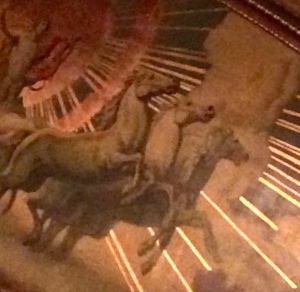 Last month, a friend visited from New York. As a good host, I tried to think of things she might like to do. As a sort of ambassador for the city I love and have called home most of my life, I tried to think of experiences that were patently Chicago.
Last month, a friend visited from New York. As a good host, I tried to think of things she might like to do. As a sort of ambassador for the city I love and have called home most of my life, I tried to think of experiences that were patently Chicago.
Of course, I took her to The Bean, Anish Kapor’s 66’ long reflective steel sculpture (officially named Cloud Gate), which is a featured attraction in Millennium Park. We took a slow walk down Michigan Avenue, one of the great shopping streets in the world, and had a Chicago style hot dog, complete with Day-Glo green pickle relish.
I took her to dinner at a small plates style tapas restaurant in the South Loop and to a concert at the Chicago Theatre.
Designed by the Rapp Brothers and built in 1921, the 3600-seat auditorium was the biggest jewel in the Balaban & Katz chain of movie theaters. The sign at the State Street entrance is a six-story high marquee, simply with the letters C-H-I-C-A-G-O running down.
Supposedly, some of its interiors were modeled after the palace at Versailles. It features a grand staircase and incredible French-themed murals. Its renovation in the mid eighties, costing over $9 million, did nothing to diminish its grandeur, although its days as a movie palace were over. In 1986, it became more of a hall for concerts and special events.
As we took our seats in Row C of the lower balcony, I couldn’t help but look up at the ceiling. I was amazed by the image of three horses pulling a chariot. It was impossible not to ask myself, Why do men paint on ceilings? and the natural follow-up, Why would someone paint on the ceiling of a theatre?
The immediate answer was simply that it was a style of the times. Movie houses in the 20s were large spaces and the owners wanted patrons to be impressed. After all, they were about to experience a new type of entertainment (cinema) and should be a little in awe.
Décor-wise and for the sake of visual balance, it would probably look off-kilter if a large auditorium, with richly colored seats and carpeting, had only a vanilla sky above. But the image of the muscular horses and fearless charioteer was stirring. I might expect a church gathering would look up towards heaven for a little inspiration, but in a theatre, especially after the lights are dimmed, I’d expect most people would direct their gaze to the stage.
Why would there be such a mural on the ceiling of the Chicago Theatre? Strictly as an element of décor? Because it was the style of the times? Something to distract patrons until the show started?
Although the practice of painting on a ceiling is old, I can’t help but look at an impressively decorated aerial expanse and not think about when the idea was new. What was it like for an audience member to see such a thing for the first time?
That’s what art does. It reminds us to consider things that have not been done before. A theatre is as good a place as any to remember this.
Maybe the best question is not Why do men paint on ceilings? but Will we ever run out of new ceilings? Will we ever lose our capacity to take a fresh look at what can be done and create something that hasn’t been done before? I hope not.
Being inspired by an old work of art because it represents artistry is no small thing.


Leave a comment